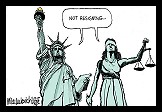E-VOTING IN BRAZIL – THE RISKS TO DEMOCRACY
We believe that our work on e-voting in Brazil should be a matter of concern in both developed and developing countries. In addition to the lack of security of e-voting technology, which is very well explored by academics in both Brazil and in the developed world, we have raised some questions that need further discussion with regards to alienation, digital divide, market-driven and voter-driven approach to e-voting.
● Alienation [1]: With the introduction of e-voting both elections and the electoral processes are no longer controlled by voters, they become the property of those who run or manage them. In this case, the voting machine maker or a multinational corporation controls the whole system and the voter is alienated from the electoral process itself. The election becomes an external phenomenon inaccessible to the voter who can no longer scrutinize it. Transparency as a basic principle of democracy is eliminated, because there is not an open and transparent counting of votes. The myth of election as a means of empowering the voter is eliminated, and the voter is alienated not only from the electoral process but also from his own vote. It is argued that “whoever controls the voting machines can control who wins the votes”.
● Market-Driven Approach [2]: When access to a technology like e-voting is created by market-driven forces or corporate actors and not by society itself, democracy is in jeopardy. It seems that e-voting is not affordable in Brazil and it was not a demand-driven option. The introduction of e-voting in Brazil was the result of discussions done behind closed doors, with corporate actors celebrating high revenues, and not the result of research work and discussions with the Brazilian society. Electronic voting should not be considered as a priority for people lacking food, health care and clean water, especially when e-voting has not actually empowered the people and eliminated corruption and frauds in elections. Without a market for e-voting systems in the developed world, corporate actors have turned to developing countries. Let us resist e-voting as it is now. At this moment, it is imperative to identify and assess the risks of e-voting machines to democracy. The praxis of e-voting must encompass the issues of e-equity, justice and social inclusion.
● The Voter-Centered Approach [1]: As the fields of Human Computer Interaction (HCI) and Computer-Supported Cooperative Work (CSCW) advance, the opportunities for participation in the information systems development have expanded considerably. In the development of an electronic voting system, the voter or citizen participation is of fundamental importance in the process of dialogue. In this case, we have diverse voices of all interested parties. There is need to focus on the humanization of the electronic voting system so that it can be developed under a more elaborated socio-political approach, expanding the concept of user-centered to a citizen or voter-centered approach. In this empowering or enabling approach, people are viewed as subjects and not as objects, users or customers. Let us avoid an approach that means the use, and abuse, of the user of the system. The history of e-voting in Brazil and all the power relations embedded in it was not told yet.
● The Digital Divide [2]: The rhetoric of the digital divide does not take into account political and social inclusion. It addresses “participation in the digital economy” issues only. It is argued that the discourse of the digital divide has failed to capture the picture of inequity and alienation. The interpretation of access in the digital divide should be done taking in consideration socio-historical, sociopolitical, and socio-cultural aspects. If we reformulate the conceptualization of the digital divide, the problem of “access”, as the heart of digital equity, began to emerge. The Electoral Justice in Brazil should think more reflexively about the dominant discourse of the digital divide and its role in “recycling old inequities”. Since the vote in Brazil is compulsory, there is an equal physical access to e-voting technology in the country. Despite the increase in physical access, e-voting is not a technology with the potential to transform lives, improve democracy, and engage citizens. It is a technology used by voters every two years, during a period of just about two minutes. Furthermore, less than 10% of the Brazilian population has access to the internet. Investments in e-voting technology are uniquely pleasing the interests of corporate actors; this is exacerbating the digital divide and other social divisions. Rather, increasing internet connectivity in public places such as schools and libraries and increasing investments in social programs can significantly help the poor and improve the democracy. At the moment, the investment in e-voting is higher than what is spent in the program of cancer control and prevention, the program of troublesome adolescent social re-inclusion, the program of income and employment generation, and so on. There is no doubt that the technological capabilities for the adoption of e-voting will exist in the near future, and in many initiatives of e-democracy and e-government. However, we need more empirical results and the construction of theories are fundamental in this new field of study either to support or to refuse what we have commented in our research work.
[1] Rodrigues Filho, Jose; Gomes. Natanael P. E-Voting in Brazil – Exacerbating Alienation and the Digital Divide. Proceedings of the 6th European Conference on e-Government, Marburg, Germany, 2006.
http://www.academic-conf...006/eceg06-abstracts.pdf
[2] Rodrigues-Filho, Jose; Alexander, Cynthia C; Batista, Luciano C. E-Voting in Brazil – The Risks to Democracy. 2nd International Workshop on E-Voting, Proceedings: Electronic Voting 2006, Bregenz, Austria, 2006.
http://www.e-voting.cc/topics/Resources/
 Voters with disabilities are being asked to call for an appointment to vote using the new, accessible machines in some New York counties. "Scheduling in advance allows boards to arrange transportation and minimize waiting periods for the ballot-marking devices, which can take up to an hour to use, elections officials say." Advocacy groups say this puts up unnecessary barriers for those voters. / Florida counties have used new voting machines for a couple years now but they still seem to be stumped on how to make the system work properly....
Voters with disabilities are being asked to call for an appointment to vote using the new, accessible machines in some New York counties. "Scheduling in advance allows boards to arrange transportation and minimize waiting periods for the ballot-marking devices, which can take up to an hour to use, elections officials say." Advocacy groups say this puts up unnecessary barriers for those voters. / Florida counties have used new voting machines for a couple years now but they still seem to be stumped on how to make the system work properly....

 Trump Gets Trumped in Our Musky Year-End Roundtable: 'BradCast' 12/19/24
Trump Gets Trumped in Our Musky Year-End Roundtable: 'BradCast' 12/19/24 'Green News Report' 12/17/24
'Green News Report' 12/17/24
 About Some of Trump's
About Some of Trump's Trump Family Corruption Cometh...So Does Our Oppo-sition: 'BradCast' 12/17/24
Trump Family Corruption Cometh...So Does Our Oppo-sition: 'BradCast' 12/17/24 'Green News Report' 12/17/24
'Green News Report' 12/17/24 Mistallied Contests Found in OH County, as Oligarchy Rises in D.C.: 'BradCast' 12/16/24
Mistallied Contests Found in OH County, as Oligarchy Rises in D.C.: 'BradCast' 12/16/24 Sunday 'Barrel Bottom' Toons
Sunday 'Barrel Bottom' Toons Trump Admits He Can't Lower Grocery Prices (Biden Just Did): 'BradCast' 12/12/24
Trump Admits He Can't Lower Grocery Prices (Biden Just Did): 'BradCast' 12/12/24 'Green News Report' 12/12/24
'Green News Report' 12/12/24 What 'Unprecedented and Powerful Mandate'?: 'BradCast' 12/11/24
What 'Unprecedented and Powerful Mandate'?: 'BradCast' 12/11/24 Trump Barely Won Nationally, But Won 'News Deserts' By a Landslide: 'BradCast' 12/10
Trump Barely Won Nationally, But Won 'News Deserts' By a Landslide: 'BradCast' 12/10 'Green News Report' 12/10/24
'Green News Report' 12/10/24 Bad Weekend for Authorit-arianism; Also: To Pardon or Not?: 'BradCast' 12/9/24
Bad Weekend for Authorit-arianism; Also: To Pardon or Not?: 'BradCast' 12/9/24 Sunday 'Teeny Tiny' Toons
Sunday 'Teeny Tiny' Toons Fox 'News' and GOP Get Their Hateful War on Trans Kids at SCOTUS: 'BradCast' 12/5/24
Fox 'News' and GOP Get Their Hateful War on Trans Kids at SCOTUS: 'BradCast' 12/5/24 'Green News Report' 12/5/24
'Green News Report' 12/5/24 'Mind Boggles at Potential Corruption' in Trump Scheme: 'BradCast' 12/4/24
'Mind Boggles at Potential Corruption' in Trump Scheme: 'BradCast' 12/4/24 In Defense of Democracy from S. Korea to N. Carolina: 'BradCast' 12/3/24
In Defense of Democracy from S. Korea to N. Carolina: 'BradCast' 12/3/24 Hunter's Pardon: 'BradCast' 12/2/24
Hunter's Pardon: 'BradCast' 12/2/24 How (and Why!) to 'Extend Olive Branch' to MAGA Members: 'BradCast' 11/21/24
How (and Why!) to 'Extend Olive Branch' to MAGA Members: 'BradCast' 11/21/24 Former Prosecutor: Sentence Trump in NY Before Taking Office: 'BradCast' 11/20/24
Former Prosecutor: Sentence Trump in NY Before Taking Office: 'BradCast' 11/20/24 'Bullet Ballot' Claims, Other Arguments for Hand-Counting 2024: 'BradCast' 11/19/24
'Bullet Ballot' Claims, Other Arguments for Hand-Counting 2024: 'BradCast' 11/19/24 Trump Already Violating Law During Transition: 'BradCast' 11/18/24
Trump Already Violating Law During Transition: 'BradCast' 11/18/24 Computer Experts Ask Harris to Seek Hand-Counts After Breaches: 'BradCast' 11/14/24
Computer Experts Ask Harris to Seek Hand-Counts After Breaches: 'BradCast' 11/14/24
 VA GOP VOTER REG FRAUDSTER OFF HOOK
VA GOP VOTER REG FRAUDSTER OFF HOOK Criminal GOP Voter Registration Fraud Probe Expanding in VA
Criminal GOP Voter Registration Fraud Probe Expanding in VA DOJ PROBE SOUGHT AFTER VA ARREST
DOJ PROBE SOUGHT AFTER VA ARREST Arrest in VA: GOP Voter Reg Scandal Widens
Arrest in VA: GOP Voter Reg Scandal Widens ALL TOGETHER: ROVE, SPROUL, KOCHS, RNC
ALL TOGETHER: ROVE, SPROUL, KOCHS, RNC LATimes: RNC's 'Fired' Sproul Working for Repubs in 'as Many as 30 States'
LATimes: RNC's 'Fired' Sproul Working for Repubs in 'as Many as 30 States' 'Fired' Sproul Group 'Cloned', Still Working for Republicans in At Least 10 States
'Fired' Sproul Group 'Cloned', Still Working for Republicans in At Least 10 States FINALLY: FOX ON GOP REG FRAUD SCANDAL
FINALLY: FOX ON GOP REG FRAUD SCANDAL COLORADO FOLLOWS FLORIDA WITH GOP CRIMINAL INVESTIGATION
COLORADO FOLLOWS FLORIDA WITH GOP CRIMINAL INVESTIGATION CRIMINAL PROBE LAUNCHED INTO GOP VOTER REGISTRATION FRAUD SCANDAL IN FL
CRIMINAL PROBE LAUNCHED INTO GOP VOTER REGISTRATION FRAUD SCANDAL IN FL Brad Breaks PA Photo ID & GOP Registration Fraud Scandal News on Hartmann TV
Brad Breaks PA Photo ID & GOP Registration Fraud Scandal News on Hartmann TV  CAUGHT ON TAPE: COORDINATED NATIONWIDE GOP VOTER REG SCAM
CAUGHT ON TAPE: COORDINATED NATIONWIDE GOP VOTER REG SCAM CRIMINAL ELECTION FRAUD COMPLAINT FILED AGAINST GOP 'FRAUD' FIRM
CRIMINAL ELECTION FRAUD COMPLAINT FILED AGAINST GOP 'FRAUD' FIRM RICK SCOTT GETS ROLLED IN GOP REGISTRATION FRAUD SCANDAL
RICK SCOTT GETS ROLLED IN GOP REGISTRATION FRAUD SCANDAL VIDEO: Brad Breaks GOP Reg Fraud Scandal on Hartmann TV
VIDEO: Brad Breaks GOP Reg Fraud Scandal on Hartmann TV RNC FIRES NATIONAL VOTER REGISTRATION FIRM FOR FRAUD
RNC FIRES NATIONAL VOTER REGISTRATION FIRM FOR FRAUD EXCLUSIVE: Intvw w/ FL Official Who First Discovered GOP Reg Fraud
EXCLUSIVE: Intvw w/ FL Official Who First Discovered GOP Reg Fraud GOP REGISTRATION FRAUD FOUND IN FL
GOP REGISTRATION FRAUD FOUND IN FL


































